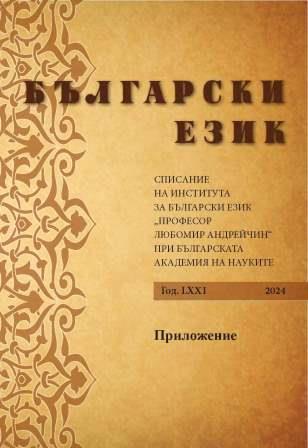За употребата на знаци за съгласна /j/ и палатализираност при предаването на шведски имена на български език: предписания и фактически тенденции в преводаческата практика
On the Use of Graphic Designations for the Consonant /J/ and Palatalisation in the Rendition of Swedish Names into Bulgarian: Prescriptions and Actual Tendencies in Translators’ Practice
Author(s): Vladimir NaydenovSubject(s): Language studies, Language and Literature Studies, Theoretical Linguistics, Applied Linguistics, Phonetics / Phonology, Comparative Linguistics, Philology
Published by: Институт за български език „Проф. Любомир Андрейчин“, Българска академия на науките
Keywords: transcription; palatalisation; orthography; Bulgarian language; Swedish language
Summary/Abstract: The article examines the variation in the use of graphical designations of the consonant /j/ and palatalisation (<й>, <ь>, <ю> и <я>) in transcriptions of Swedish names into Bulgarian, on the one hand, according to prescriptions published since the 1970s for Swedish (by I. Duridanov in 1974, P. Stoyanov in 1982, and Ordinance No. 6 of 12 June 1995) and for foreign languages in general (by L. Andreychin in 1974, Grammar of the Modern Bulgarian Literary Language in 1983, and the Official Orthographic Dictionary of the Bulgarian Language in 2012), and on the other – in actual translators’ practice as observed in examined publications from the late 1960s to the present day. The variation encompasses, above all, the rendition of: 1. the allophones [ʉ̟ː] and [ɵ] of the Swedish phoneme /ʉ/; 2. the Swedish phonemes /y/ and /ø/, above all in positions after consonants transcribed into Bulgarian with <ш> and <ч>; 3. the Swedish consonant /ʝ/ after another consonant, especially before a consonant transcribed with <е>, word-finally and initially in a non-first member of a compound; 4. sequences of a vow-el rendered with <и> or <е> and a vowel rendered with <а>. In spite of significant vacillations and inconsistencies the predominating approaches to case 1 and 2 are the ones recommended by P. Stoyanov and Ordinance No. 6. With respect to word-final /ʝ/ observance of the prescription found in Ordinance No. 6 becomes more common in the 2010s, but remains less usual than the traditional rendition recommended by I. Duridanov. With respect to case 3 and 4 the variation remains significant.
Journal: Български език
- Issue Year: 71/2024
- Issue No: Special
- Page Range: 213-226
- Page Count: 14
- Language: Bulgarian

